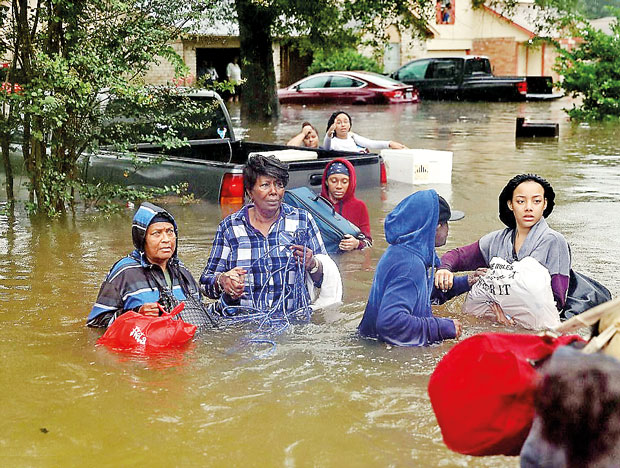30 Aug 2017 - {{hitsCtrl.values.hits}}

By Dylan Baddour, Sandhya Somashekhar, Mark Berman · (c) 2017, The Washington Post · Aug 29, 2017 -
HOUSTON - The remnants of Hurricane Harvey pelted Texas on Monday as forecasters warned that the soaking rains would continue for days and major flooding would spread to neighboring states.
Texas officials said that at least nine people had died statewide as a result of the storm, as floodwaters continued to turn streets into waterways and gush into buildings Monday, a full two days after Harvey made landfall. Authorities expect the death toll to rise as rescue efforts go on and as more rain, rising rivers and surging floodwaters pummel the Gulf Coast. President Trump late Monday pledged swift action by the federal government to provide relief to states affected by Harvey, and he is scheduled to visit Texas on Tuesday.
“Recovery will be a long and difficult road, and the federal government stands ready, willing and able to assist in that effort,” he said during a joint news conference with Finnish President Sauli Niinisto. First responders and good Samaritans took to boats to rescue stranded residents, with authorities warning that more than 30,000 people across the region could be forced from their homes by the time skies are expected to clear later this week.
“We are not out of the woods yet,” Elaine Duke, the acting Homeland Security secretary, said during a Monday briefing in Washington. “Harvey is still a dangerous and historic storm.” Fears also grew beyond Texas, with particular concern centering on flood-prone Louisiana, where forecasts have called for as much as two feet of rainfall in some areas. Trump on Monday declared “emergency conditions” in Louisiana, evoking memories of Hurricane
Katrina in 2005.
As if to underscore those fears, the U.S. Army Corps of Engineers early Monday began releasing water from two Houston dams to relieve pressure from the downpour, which has deposited as much rain in a few days as the region averages in an entire year. Most of the damage in New Orleans wrought by Katrina occurred when levees burst, allowing waters to inundate the city.
Every major waterway in the city spilled over its banks. Gullies overflowed. Even neighborhoods far from a creek or bayou flooded. The hardest-hit areas were in the south and southeast, the downstream end of the waterways.
But the southwest will be the next theater for catastrophe. The Brazos River, which runs through Fort Bend County about 20 miles west of downtown Houston, has been swelling as the runoff from the storm collects in its banks. National Weather Service models showed the river rising to 59 feet by Tuesday, topping the previous record of 54.7 feet. Authorities issued mandatory and voluntary evacuation orders for parts of that area and warned that anyone who ignores mandatory evacuation orders will not be aided by first responders when the waters rise. But with virtually all the main thoroughfares already closed because of high water, many of the affected residents saw no way out.
Kim Adoubeif, 60, was among about a dozen residents of the Greatwood subdivision who stood in the rain atop a levee on the Brazos River on Monday to gaze at the water and ponder their fate. She said she checked online traffic maps and couldn’t find a route to safety.
“Every way out, there are roads that are flooded,” she said, holding an umbrella against the rain. “So we might not even find a way out.”
Some who did evacuate ran into difficulties Monday as they tried to reach shelters. In north Houston, for example, rescuers who picked up people forced out of their drenched homes brought them to a fire station to be transported to the M.O. Campbell Center, a school gym and activity center that had been converted to a shelter. But when the shelter reached capacity, its doors were shut, and at least 300 people were stranded at the fire station.
The horror stories led authorities to urge patience and persistence on the part of residents needing help.
16 Nov 2024 21 minute ago
16 Nov 2024 27 minute ago
16 Nov 2024 33 minute ago
16 Nov 2024 39 minute ago
16 Nov 2024 3 hours ago